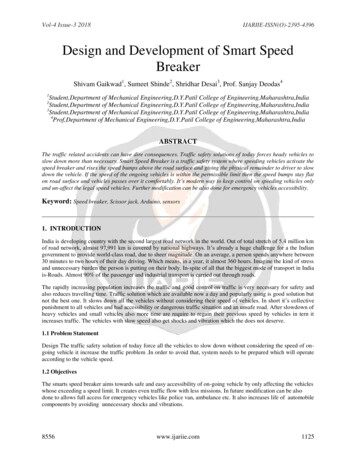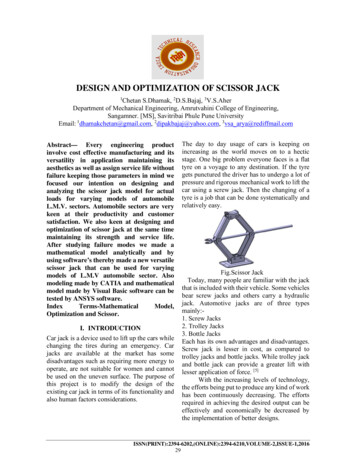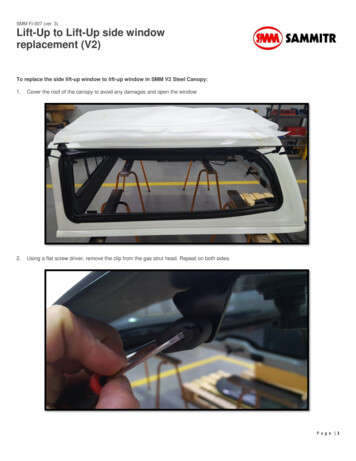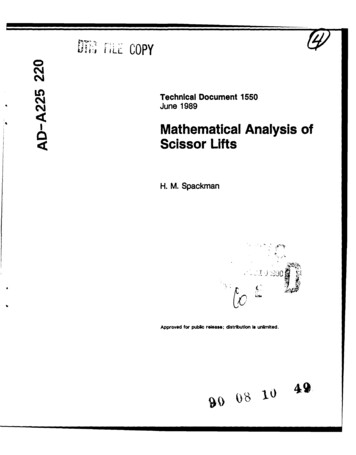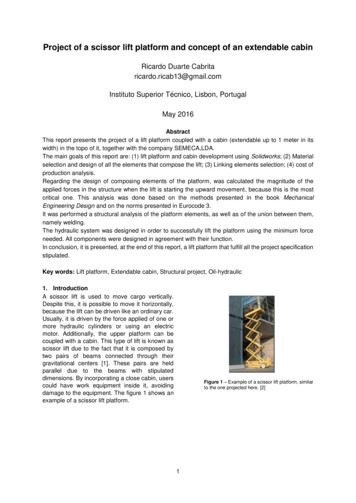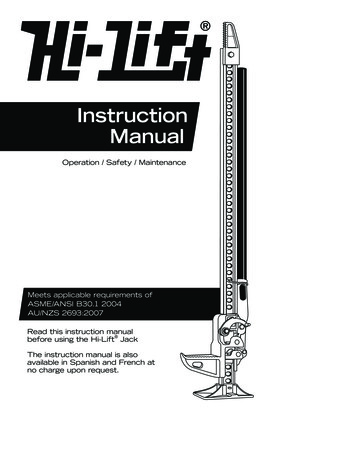
Transcription
InstructionManualOperation / Safety / MaintenanceMeets applicable requirements ofASME/ANSI B30.1 2004AU/NZS 2693:2007Read this instruction manualbefore using the Hi-Lift JackThe instruction manual is alsoavailable in Spanish and French atno charge upon request.
ContentsHi-Lift Jack Components. . . . . . . . . . . . . . . . . . .1Safety. . . . . . . . . . . . . . . . . . . . . . . . . . . . . . . . . . . . .3Safety Symbols. . . . . . . . . . . . . . . . . . . . . . . . . . . . . 3Safety Warnings. . . . . . . . . . . . . . . . . . . . . . . . . . . . .4Handle Safety Decal . . . . . . . . . . . . . . . . . . . . . . . . . 5General Safety. . . . . . . . . . . . . . . . . . . . . . . . . . . . . .6Operation Instructions . . . . . . . . . . . . . . . . . . . . . 7Raising a Stationary Load. . . . . . . . . . . . . . . . . . . . . .7Lowering a Stationary Load . . . . . . . . . . . . . . . . . . . 10Clamping or Winching. . . . . . . . . . . . . . . . . . . . . . . 11Maintenance Instructions. . . . . . . . . . . . . . . . . .13Clean . . . . . . . . . . . . . . . . . . . . . . . . . . . . . . . . . . . 13Binding . . . . . . . . . . . . . . . . . . . . . . . . . . . . . . . . . .13Storing the Jack. . . . . . . . . . . . . . . . . . . . . . . . . . . .13Storing the Equipment-Agricultural Jack. . . . . . . . . . 13Inspection . . . . . . . . . . . . . . . . . . . . . . . . . . . . . . . 13Lubrication . . . . . . . . . . . . . . . . . . . . . . . . . . . . . . . 14Repair. . . . . . . . . . . . . . . . . . . . . . . . . . . . . . . . . . . 14Parts. . . . . . . . . . . . . . . . . . . . . . . . . . . . . . . . . . . . 16Specifications . . . . . . . . . . . . . . . . . . . . . . . . . . . 18Limited Warranty. . . . . . . . . . . . . . . . . . . . . . . . 20
Hi-Lift Jack CompanyP.O. Box 228Bloomfield, IN 47424-0228 USAToll Free: 800.233.2051Direct: 812.384.4441Fax: 812.384.4592Web: http://www.hi-lift.comTo the Owner / UserThank you for purchasing this Hi-Lift Jack. With proper use and care,your jack will give you years of dependable service. You can use the Hi-Lift Jack in many ways, including: Lifting stable loads. Winching loads. Clamping Spreading. Raising vehicles or other mobile loads (when properly chocked, blockedand stabilized).Store these instructions in the handle of your jack. Use only genuine Hi-Lift replacement parts. Using replacement parts not supplied by Hi-Lift Jack Company will make the jack unsafe for use and void the warranty.
Hi-Lift Jack ComponentsGet to know the components of your jack before you begin use.Top clamp-clevisTop clamp-clevis bolt & nutSteel standard barSteel standard bar holesHandlePitmanLarge runnerSmall runnerCotter pinBase plate1
Components · Running GearThe following shows the parts associated with the running gear:Handle clip springHandle socketPitman pinReversing switch cam barHex bolt & nutReversing latchCross pinClimbing pin springShear bolt & nutClimbing pinCross pinClimbing pin springClimbing pinCap screw with washer2
Safety · WarningsSafetyAll users must read and understand the instructions and safety warnings in this manual andthe safety labels placed on the product before using the jack. Each user must use the jacksafely and maintain it properly.If any users are not fluent in English, have someone read the instructions to them. Manualsare also available in other languages upon request at no charge.If you have any questions about using the jack safely or if you need a new label or manual,see the contact information on the opposite page.Safety Symbols! DANGERThe DANGER! safety symbol indicates a hazard or unsafe practice that will result in serious injury or death.! WARNINGThe WARNING! safety symbol indicates a hazard or unsafe practice that could result in serious injury or death.3
Safety Warnings! DANGERDO NOT USE THE JACK TO SUPPORT OR STABILIZE A LOAD. Using the jack to support orstabilize a load may result in unexpected movement and result in serious injury, being crushed anddeath. Always securely chock and block (stabilize) the load to be lifted. Never place any part of thebody under a raised load without properly chocking and supporting the load.Using the jack on curved or tubular vehicle bumpers will result in the vehicle slipping off the jackand falling, causing serious injury or death. Use the Bumper Lift or Lift-Mate to lift most vehicleswith curved bumpers or plastic bumpers.When using the jack as a winch:Always use chains or tow straps that have a greater working load than the jack. If a chain or towstrap breaks while winching, the load could shift or the chain or tow strap could snap back.When used as a winch, the top clamp-clevis will support up to 5,000 lbs. (2273 kg). Going overthis limit will result in the top clamp-clevis bending or breaking, causing the load to move or thechain or tow strap to snap back. This will result in serious injury or death.When using the jack for clamping, the maximum clamping force of the standard top clamp-clevisis 750 lbs. (340 kg). If you exceed this limit, the standard top clamp-clevis could bend or break,resulting in serious injury or death.Unexpected movement of the jack handle may result in the user being struck causing seriousinjury or death. Always keep your head away from and out of the jack handle path of movement.The jack handle may move rapidly when moving the reversing latch and cause serious injury ordeath. Always place the handle against the steel standard bar with the handle clip spring holdingit up before moving the reversing latch. This will prevent the handle from moving up and downrapidly. Securely hold on to the jack handle so your hands do not slip and ensure the handle is notin the horizontal position when moving the reversing latch.Important! During lifting and lowering, the weight of the load pushes up against the jack’s handle.If your hands slip off the handle, or if the handle is horizontal when you move the reversing latch, itmay move up very quickly.Raising an inflated tire more than 2” (5cm) above the ground or attempting to lift more than onewheel at a time may result in tip over, unexpected movement and serious injury or death. Alwaysraise an inflated tire less than 2” (5cm) and only one tire at a time.! WARNINGThe jack, while standing vertical and unsupported, may tip over and cause serious injury ordeath. Always support the jack or lay it on it’s side when not in use.This jack will not operate safely without proper lubrication. Using the jack without proper lubrication will result in poor performance and damage to the jack. The jack is not self-lubricating,inspect the jack before use and lubricate when necessary.4
not in the horizontal position when moving thereversing latch.Handle Safety DecalImportant! Replace handle safety decal if damaged or removed.The following hazards or unsafe practiceswill cause serious injury or deathDO NOT USE THE JACK TO SUPPORT OR STABILIZEA LOAD. Using the jack to support or stabilize aload may result in unexpected movement andresult in serious injury, being crushed and death.Always securely chock and block (stabilize) theload to be lifted. Never place any part of the bodyunder a raised load without properly chockingand supporting the load.Using the jack on curved or tubular vehiclebumpers will result in the vehicle slipping off thejack and falling, causing serious injury or death.Use the Bumper Lift or Lift-Mate to lift mostvehicles with curved bumpers or plastic bumpers.When using the jack as a winch:Always use chains or tow straps that have agreater working load than the jack. If a chain ortow strap breaks while winching, the load couldshift or the chain or tow strap could snap back.When used as a winch, the top clamp-clevis willsupport up to 5,000 lbs. (2273 kg). Going over thislimit will result in the top clamp-clevis bending orbreaking, causing the load to move or the chainor tow strap to snap back. This will result inserious injury or death.When using the jack for clamping, the maximumclamping force of the standard top clamp-clevis is750 lbs. (340 kg). If you exceed this limit, thestandard top clamp-clevis could bend or break,resulting in serious injury or death.Unexpected movement of the jack handle mayresult in the user being struck causing seriousinjury or death. Always keep your head away fromand out of the jack handle path of movement.The jack handle may move rapidly when movingthe reversing latch and cause serious injury ordeath. Always place the handle against the steelstandard bar with the handle clip spring holdingit up before moving the reversing latch. This willprevent the handle from moving up and downrapidly. Securely hold on to the jack handle soyour hands do not slip and ensure the handle isnot in the horizontal position when moving thereversing latch.Important! During lifting and lowering, theweight of the load pushes up against the jack’shandle. If your hands slip off the handle, or if thehandle is horizontal when you move the reversinglatch, it may move up very quickly.Raising an inflated tire more than 2” (5cm) abovethe ground or attempting to lift more than onewheel at a time may result in tip over, unexpectedmovement and serious injury or death. Alwaysraise an inflated tire less than 2” (5cm) and onlyone tire at a time.Handle force required to raise 4,660 lbs. is 177lbs. at 34” on the handle. Maximum rated load is4,660 lbs. (2273 kg) up to 48” (121 cm), tested to7,000 lbs. (3175 kg). Upper 12” of 60” jack israted to 2,660 lbs. (1209 kg) only, tested to 4,000lbs. (1818 kg). If you overload the jack duringoperation, the shear bolt will break. If the shearbolt breaks, as it will at 7,000 lbs. (3175 kg), theload should be supported, but the jack’s handlewill drop freely. Use a jack with a larger loadcapacity to lower the load safely to the ground.Do not replace the shear bolt with a bolt ofgreater strength as this could cause the jack tofail and drop the load. Always use a shear boltsupplied by Hi-Lift Jack Company. Do notreplace the shear bolt while the jack is underload.The following hazards or unsafe practicesmay cause serious injury or deathThe jack, while standing vertical andunsupported, may tip over and cause seriousinjury or death. Always support the jack or lay iton it’s side when not in use.This jack will not operate safely without properlubrication. Using the jack without properlubrication will result in poor performance anddamage to the jack. The jack is notself-lubricating, inspect the jack before use andlubricate when necessary.All users must read and understand theinstructions and safety warnings in theinstruction manual and on this product beforeusing the jack. Each user must use the jacksafely and maintain it properly.If any users are not fluent in English, havesomeone read the instructions to them.Manuals are also available in other languagesupon request at no charge.If you have any questions about using the jacksafely, need a new label or manual contact:Hi-Jack CompanyP.O. Box 228Bloomfield, IN 47424-0228 USAToll Free: 800.233.2051Direct: 812.384.4441Fax: 812.384.4592Web: http://www.hi-lift.comThe following hazards or unsafe practiceswill cause serious injury or deathDO NOT USE THE JACK TO SUPPORT OR STABILIZEA LOAD. Using the jack to support or stabilize aload may result in unexpected movement andresult in serious injury, being crushed and death.Always securely chock and block (stabilize) theload to be lifted. Never place any part of the bodyunder a raised load without properly chockingand supporting the load.Using the jack on curved or tubular vehiclebumpers will result in the vehicle slipping off thejack and falling, causing serious injury or death.Use the Bumper Lift or Lift-Mate to lift mostvehicles with curved bumpers or plastic bumpers.When using the jack as a winch:Always use chains or tow straps that have agreater working load than the jack. If a chain ortow strap breaks while winching, the load couldshift or the chain or tow strap could snap back.When used as a winch, the top clamp-clevis willsupport up to 5,000 lbs. (2273 kg). Going over thislimit will result in the top clamp-clevis bending orbreaking, causing the load to move or the chainor tow strap to snap back. This will result inserious injury or death.When using the jack for clamping, the maximumclamping force of the standard top clamp-clevis is750 lbs. (340 kg). If you exceed this limit, thestandard top clamp-clevis could bend or break,resulting in serious injury or death.Unexpected movement of the jack handle mayresult in the user being struck causing seriousinjury or death. Always keep your head away fromand out of the jack handle path of movement.The jack handle may move rapidly when movingthe reversing latch and cause serious injury ordeath. Always place the handle against the steelstandard bar with the handle clip spring holdingit up before moving the reversing latch. This willprevent the handle from moving up and downrapidly. Securely hold on to the jack handle soyour hands do not slip and ensure the handle isnot in the horizontal position when moving thereversing latch.Important! During lifting and lowering, theweight of the load pushes up against the jack’shandle. If your hands slip off the handle, or if thehandle is horizontal when you move the reversinglatch, it may move up very quickly.Raising an inflated tire more than 2” (5cm) abovethe ground or attempting to lift more than onewheel at a time may result in tip over, unexpectedmovement and serious injury or death. Alwaysraise an inflated tire less than 2” (5cm) and onlyone tire at a time.Handle force required to raise 4,660 lbs. is 177lbs. at 34” on the handle. Maximum rated load is4,660 lbs. (2273 kg) up to 48” (121 cm),5tested to7,000 lbs. (3175 kg). Upper 12” of 60” jack is· WarningsImportant! During lifting andSafetylowering,theweight of the load pushes up against the jack’shandle. If your hands slip off the handle, or if thehandle is horizontal when you move the reversinglatch, it may move up very quickly.Raising an inflated tire more than 2” (5cm) abovethe ground or attempting to lift more than onewheel at a time may result in tip over, unexpectedmovement and serious injury or death. Alwaysraise an inflated tire less than 2” (5cm) and onlyone tire at a time.Handle force required to raise 4,660 lbs. is 177lbs. at 34” on the handle. Maximum rated load is4,660 lbs. (2273 kg) up to 48” (121 cm), tested to7,000 lbs. (3175 kg). Upper 12” of 60” jack israted to 2,660 lbs. (1209 kg) only, tested to 4,000lbs. (1818 kg). If you overload the jack duringoperation, the shear bolt will break. If the shearbolt breaks, as it will at 7,000 lbs. (3175 kg), theload should be supported, but the jack’s handlewill drop freely. Use a jack with a larger loadcapacity to lower the load safely to the ground.Do not replace the shear bolt with a bolt ofgreater strength as this could cause the jack tofail and drop the load. Always use a shear boltsupplied by Hi-Lift Jack Company. Do notreplace the shear bolt while the jack is underload.The following hazards or unsafe practicesmay cause serious injury or deathThe jack, while standing vertical andunsupported, may tip over and cause seriousinjury or death. Always support the jack or lay iton it’s side when not in use.This jack will not operate safely without properlubrication. Using the jack without properlubrication will result in poor performance anddamage to the jack. The jack is notself-lubricating, inspect the jack before use andlubricate when necessary.All users must read and understand theinstructions and safety warnings in theinstruction manual and on this product beforeusing the jack. Each user must use the jacksafely and maintain it properly.If any users are not fluent in English, havesomeone read the instructions to them.Manuals are also available in other languagesupon request at no charge.If you have any questions about using the jacksafely, need a new label or manual contact:Hi-Jack CompanyP.O. Box 228Bloomfield, IN 47424-0228 USAToll Free: 800.233.2051Direct: 812.384.4441Fax: 812.384.4592Web: http://www.hi-lift.com
Safety · GeneralGeneral SafetyTraining Read this manual before use. Do not allow anyone who has not read this manual, and/or does not understand the requirements, use the jack.Spectators Do not allow bystanders around the jack or under the load supported only by the jack.Inspection Inspect the jack carefully before each use. Ensure the jack is not damaged, excessively worn, or missingparts. Check the climbing pins to make sure that they are not worn or damaged. Check the steel standard bar to make sure that it is straight and that nothing is blocking the steel standardbar holes. Do not use the jack unless it is in good clean working condition. Do not use the jack unless it is properly lubricated. Using a jack that is not in good clean working condition or properly lubricated may cause serious injury(see Lubrication).Chock and Block (Stabilize)A chock is a wedge for steadying an object and holding it motionless, or for preventing the movement of awheel. Chock the wheel opposite the end being lifted.When you block a load, you secure and support a load that is being lifted. The block(s) or stabilizer(s) shouldhave a weight capacity that is greater than the weight of the load which is being lifted. Do not use the jack tosupport the load.Blocks stabilize the loadChocks prevent movement6
Operation InstructionsRaising a Stationary Load! DANGERDO NOT USE THE JACK TO SUPPORT OR STABILIZE A LOAD. Using the jack to support orstabilize a load may result in unexpected movement and result in serious injury, being crushedand death. Always securely chock and block (stabilize) the load to be lifted. Never place anypart of the body under a raised load without properly chocking and supporting the load.Using the jack on curved or tubular vehicle bumpers will result in the vehicle slipping off thejack and falling, causing serious injury or death. Use the Bumper Lift or Lift-Mate to lift mostvehicles with curved bumpers or plastic bumpers.Unexpected movement of the jack handle may result in the user being struck causing seriousinjury or death. Always keep your head away from and out of the jack handle path of movement.The jack handle may move rapidly when moving the reversing latch and cause serious injuryor death. Always place the handle against the steel standard bar with the handle clip springholding it up before moving the reversing latch. This will prevent the handle from moving upand down rapidly. Securely hold on to the jack handle so your hands do not slip and ensure thehandle is not in the horizontal position when moving the reversing latch.Important! During lifting and lowering, the weight of the load pushes up against the jack’s handle. If your hands slip off the handle, or if the handle is horizontal when you move the reversinglatch, it may move up very quickly.Raising an inflated tire more than 2” (5cm) above the ground or attempting to lift more thanone wheel at a time may result in tip over, unexpected movement and serious injury or death.Always raise an inflated tire less than 2” (5cm) and only one tire at a time.Handle force required to raise 4,660 lbs. is 177 lbs. at 34” on the handle. Maximum rated loadis 4,660 lbs. (2273 kg) up to 48” (121 cm), tested to 7,000 lbs. (3175 kg). Upper 12” of 60”jack is rated to 2,660 lbs. (1209 kg) only, tested to 4,000 lbs. (1818 kg).If you overload the jack during operation, the shear bolt will break. If the shear bolt breaks, as itwill at 7,000 lbs. (3175 kg), the load should be supported, but the jack’s handle will drop freely.Use a jack with a larger load capacity to lower the load safely to the ground. Do not replace theshear bolt with a bolt of greater strength as this could cause the jack to fail and drop the load.Always use a shear bolt supplied by Hi-Lift Jack Company. Do not replace the shear bolt whilethe jack is under load.7
Operation · Raising a Stationary Load1. Securely chock and stabilize the load to prevent it from rolling or shifting as you lift it (see General Safety:Chock and Block).2. Place the jack’s base plate securely on a firm, level, and dry surface with the steel standard bar pointingstraight up.3. Lift the reversing latch until it locks in the up position.4. Pull the handle away from the steel standard bar, releasing the handle clip spring.5. Grasp the handle or the handle socket and raise the lifting mechanism until the large runner is completelyand securely under the load.61435Important!Keep the handle against steel standard bar with the handle clip springholding it when not lifting or lowering.26. Grasp the handle firmly with both hands. Carefully pump the handle up and down to raise the load. Do notuse an extension on the handle.The load will be raised on each down stroke of the handle. Watch the load and the jack carefully. Stop lifting if either one starts to move. Do not continue until it is safe to do so. When safe, stabilize and block theload.7.When the load is raised to the desired height, place the handle in the upright position clipped to the steelstandard bar.8. Block the load securely.9. Lower the load onto the blocks (see Lowering a Stationary Load).10. Remove the jack from the stabilized load.8
Operation · Raising a Stationary Load798Additional Instructions For Equipment-Agricultural Jack1. When attaching the Equipment-Agricultural jack to equipment using tubular mounting brackets, alwaysplace lock-pin completely through the holes in the tubular mounting bracket.2. Always secure the lock-pin in the tubular brackets with the safety cotter pin.3. Chock the equipment that you have attached the Equipment-Agricultural jack to before lifting with theEquipment-Agricultural jack. Side lift is limited to 2,000 lbs. (907 kg).After you have properly hooked the raised equipment to a mobile vehicle, lower the lifting mechanism ofthe Equipment Agricultural jack to its base and move the reversing latch into the up position.9
Operation · Lowering a Stationary LoadLowering a Stationary Load! DANGERUnexpected movement of the jack handle may result in the user being struck causing serious injuryor death. Always keep your head away from and out of the jack handle path of movement.The jack handle may move rapidly when moving the reversing latch and cause serious injury ordeath. Always place the handle against the steel standard bar with the handle clip spring holding it up before moving the reversing latch. This will prevent the handle from moving up and downrapidly. Securely hold on to the jack handle so your hands do not slip and ensure the handle is notin the horizontal position when moving the reversing latch.Important! During lifting and lowering, the weight of the load pushes up against the jack’s handle.If your hands slip off the handle, or if the handle is horizontal when you move the reversing latch, itmay move up very quickly.The jack must have a load of 150 lbs. or more to lower step-by-step. Otherwise, the lifting mechanism willslide down to the base plate, dropping your load. Ensure all bystanders are clear of the load being lowered.1. Position the jack under the raised load and raise the stationary load (see Raising a Stationary Load).2. Remove blocks from under the load.3. Be sure the handle is in the upright position clipped to the steel standard bar before lowering the load.4. Move the reversing latch to the down position.5. Grasp the handle firmly with both hands. Carefully pump the handle up and down to lower the load.6. The load will be lowered on each up stroke of the handle (refer to Binding if the jack binds).534110
Operation · Clamping or WinchingClamping or Winching! DANGERWhen using the jack as a winch:Always use chains or tow straps that have a greater working load than the jack. If a chain or towstrap breaks while winching, the load could shift or the chain or tow strap could snap back.When used as a winch, the top clamp-clevis will support up to 5,000 lbs. (2273 kg). Going overthis limit will result in the top clamp-clevis bending or breaking, causing the load to move or thechain or tow strap to snap back. This will result in serious injury or death.When using the jack for clamping, the maximum clamping force of the standard top clamp-clevisis 750 lbs. (340 kg). If you exceed this limit, the standard top clamp-clevis could bend or break,resulting in serious injury or death.Clamping1. Loosen the standard top clamp-clevis bolt.2. Turn the top clamp-clevis 90 to the steel standard bar, and re-tighten the bolt.Note: You can connect the top clamp-clevis anywhere along the steel standard bar to use the jack as aclamp.3. Operate the jack as you would for raising a load (see Raising a Stationary Load).31211
Operation · Clamping or WinchingWinching1. Make sure the top clamp-clevis is in line with the steel standard bar.2. Install one end of a chain or tow strap securely to the object to be winched. Securely attach the other endof the chain or tow strap to the top clamp-clevis of the jack.Note: Use a shackle if the chain or tow strap will not fit through the top clamp-clevis of the jack.3. Take another chain or tow strap and secure one end to a fixed, stable object. Attach the other end of thechain or tow strap to the large runner on the jack (do not attach chain or shackle to bottom hole of thelarge runner on the jack). If the fixed object is a tree, follow “Tread Lightly” principles and use a tree strap.4. Operate the jack as you would for raising a load (See Raising a Stationary Load).4213Tip: Use the Hi-Lift Off-Road Kit for items you need for winching which includes; custom winch attachments, D-ring shackle,gloves and a tree strap.12
Maintenance InstructionsIf you use and maintain your Hi-Lift jack properly, it will give you many years of service. Follow the maintenance instructions carefully to keep your jack in good working condition. NEVER PERFORM MAINTENANCEON THE JACK WHILE IT IS UNDER LOAD.CleaningIf the moving parts of the jack or the standard bar are clogged, use air pressure, water pressure, or a stiffbrush to clean. Use a non-flammable cleaning solvent or another good de-greaser to clean the jack. Removeany existing rust, preferably with a penetrating lubricant.BindingIf the climbing pins start to bind in the holes of the standard bar the jack will not operate properly andsafely. Rusty climbing pins, dirt, or worn bar can be causes of binding.Clean and lubricate the lifting mechanism as indicated in the Lubrication section. Test the jack by lifting itup without a load. If the binding continues, send it to our Factory Service for repair. If the jack binds whileunder a load, use a jack with equal or larger load capacity to lower the load safely to the ground. After unbinding the jack clean, lubricate and test as described at the start of this paragraph.Storing the Jack1. Place the handle in the upright clipped position against the steel standard bar.2. Raise the reversing latch until it locks in the up position.3. Store in the upright clipped position in a dry location, preferably indoors.Tip: If the jack is stored outdoors, consider using a Hi-Lift protective cover accessory.Storing the Equipment-Agricultural Jack1. Pivot the Equipment-Agriculture jack to a horizontal position. Rest the steel handle of the Equipment-Agricultural jack on top of the steel standard bar.2. Secure the jack in this position with the lock-pin through the holes in the tubular mounting bracket.3. Secure the lock-pin in the tubular mounting brackets with the safety cotter pin.InspectionYou should inspect the jack for damage, wear, broken or missing parts (e.g.: climbing pins) and functionality before each use (see General Safety: Inspection). Follow lubrication and storage instructions for optimumjack performance.13
Maintenance InstructionsLubrication! WARNINGUsing the jack without proper lubrication will result in poor performance and damage to the jack. The jack isnot self-lubricating, inspect the jack before use and lubricate when necessary. After cleaning, lubricate thejack using light penetrating oil, or a silicon or Teflon spray at the following points:Steel Standard Bar: Keepthe front and back edgeslightly lubricated and freefrom dirt and rust.Pitman Pin: Damage to thehandle socket will occur if notlubricatedSprings: Keep clean andlubricated and free fromdirt and rust.Shear Bolt: Wear to the bolt will occur if not lubricatedImportant! Do not use motor oilor grease to lubricate the jack.Climbing Pins: Keep clean and lubricated and free from dirt and rustRepairIf you need to repair your jack, use only genuine Hi-Lift parts. Using parts not supplied by Hi-Lift Jack Company will make the jack unsafe for use and void the warranty. Hi-Lift will repair a damaged jack. Pack thejack in a carton and send prepaid to the address below:Hi-Lift Jack CompanyFactory Service Department46 West Spring StreetBloomfield, Indiana 47424The repaired jack will be returned to you via USPS, UPS or Fed Ex.14
This Page Intentionally Blank15
Parts12531146712813914101516191718212016
PartsThe following are the parts for all Hi-Lift jacks. You can order parts from your dealer or directly from our factoryby calling (800) 233-2051 (or 812-384-4441 from outside the USA). For other options visit www.hi-lift.com.1. Top clamp-clevis2. Top clamp-clevis bolt & nut3. Steel standard bar4. Reversing latch5. Handle clip spring6. Cap screw with washer7. Steel handle with cotter pin8. Handle socket9. Pitman pin10. Pitman11. Hex bolt & nut12. Large runner13. Reversing switch spring14. Reversing switch cam bar15. Cross pin16. Climbing pin17. Climbing pin spring18. Small runner19. Shear bolt & nut20. Foot piece with cotter pin21. Complete running gear17
SpecificationsWeightWidthHeightDepthRated LoadRated Load Upper 12”Tested LoadTested Load Upper 12”Rated Side LoadClampingWinchingMax. Lift height at NoseMin. Lift height at
Raising vehicles or other mobile loads (when properly chocked, blocked and stabilized). Store these instructions in the handle of your jack. Use only genuine Hi-Lift replacement parts. Using replacement parts not supplied by Hi-Lift Jack Com-pany will make the jack unsafe for use and void the warranty.
